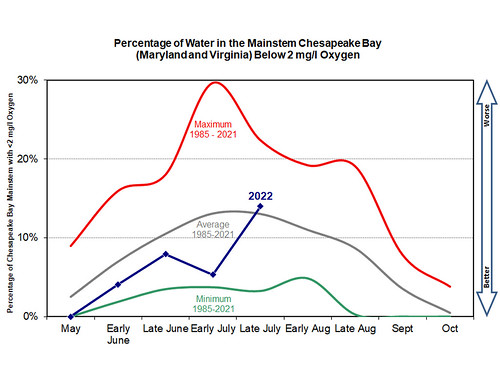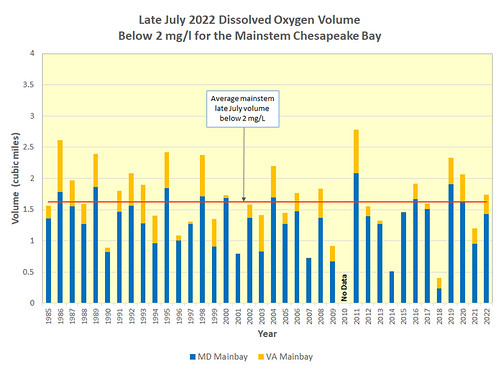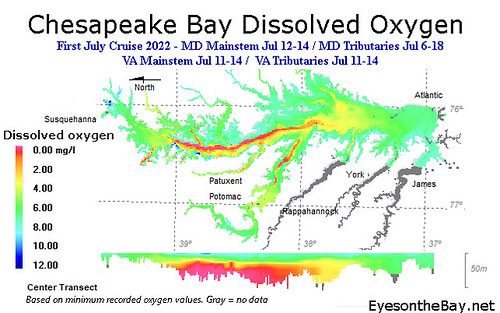Chesapeake Bay Hypoxia Report – July 2022
Conditions Were Positive to Average As Month Progressed
 Data collected by the Maryland Department of Natural Resources (DNR) and Old Dominion University show that dissolved oxygen conditions in the Chesapeake Bay mainstem of Maryland and Virginia were mixed in July 2022, with early July hypoxic volumes well below average, and late July near average. The hypoxic water volume — waters with less than 2 mg/l oxygen — was 0.66 and 1.74 cubic miles during early and late July monitoring cruises, compared to historical early and late July averages (1985-2021) of 1.63 and 1.62 cubic miles.
Data collected by the Maryland Department of Natural Resources (DNR) and Old Dominion University show that dissolved oxygen conditions in the Chesapeake Bay mainstem of Maryland and Virginia were mixed in July 2022, with early July hypoxic volumes well below average, and late July near average. The hypoxic water volume — waters with less than 2 mg/l oxygen — was 0.66 and 1.74 cubic miles during early and late July monitoring cruises, compared to historical early and late July averages (1985-2021) of 1.63 and 1.62 cubic miles.
During their respective time periods, early July hypoxic volume ranked as the fourth lowest on record, while late July was near the historical median rank of the past 38 years. Additionally, a small volume of less than 0.1 cubic miles of anoxia (waters with less than 0.2 mg/l oxygen) was observed during early July, and 0.45 cubic miles of anoxia was reported in late July.
Hypoxia in early July was mostly confined to the Maryland portion of the Bay’s center channel, but expanded laterally across the Bay and farther south into Virginia in late July. Freshwater flow, as estimated by the U.S. Geological Survey, was below average in June 2022, which may have accounted for less inflow of hypoxia-inducing nutrients in early July. Estimates for the entire month were not yet available. Bay waters in late July exhibited greater vertical stratification and a broader range of water temperature and salinity — conditions which can prevent oxygen from reaching deeper waters.
Due to weather and resource constraints, five lower Maryland Bay stations – CB5.3, CB4.3E, CB4.3W, CB4.2E, and CB4.2W – were not sampled in late July, which could impact Bay-wide results at that time.
Maryland and Virginia combined results are presented for the mainstem Bay to be more comparable to the yearly seasonal forecast by the U.S. Environmental Protection Agency Chesapeake Bay Program, U.S. Geological Survey, University of Maryland Center for Environmental Science, and University of Michigan.
The 2022 forecast, released in late June, expected Chesapeake Bay mainstem hypoxic volume to be 13% lower than the 37-year average due to reduced river flows from January through May 2022, as well as less nitrogen carried to the Bay because of nutrient management efforts. Maryland and Virginia’s monitoring results thus far have matched the forecast of better-than-average conditions.
Crabs, fish, oysters, and other creatures in the Chesapeake Bay require oxygen to survive. Scientists and natural resource managers study the volume and duration of Bay hypoxia to determine possible impacts to aquatic life in the nation’s largest estuary.
Each year from May through October, DNR computes hypoxia volumes from the water quality data collected by DNR and Virginia Department of Environmental Quality.
Data collection is funded by these states and the Chesapeake Bay Program. Bay hypoxia monitoring and reporting will continue through the summer. Additional Maryland water quality data and information, including DNR’s hypoxic volume calculation methods, can be found at DNR’s Eyes on the Bay website.




